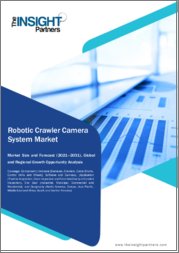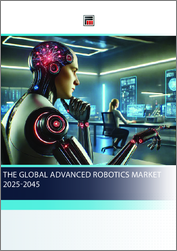
|
시장보고서
상품코드
1468105
로봇 기술 시장 보고서 : 컴포넌트, 로봇 유형, 용도, 지역별(2024-2032년)Robotics Technology Market Report by Component, Robot Type, Application, and Region 2024-2032 |
||||||
세계의 로봇 기술 시장 규모는 2023년에 986억 달러에 달했습니다. 향후 IMARC Group은 2024-2032년에 9.51%의 성장률(CAGR)을 보이며, 2032년까지 2,287억 달러에 달할 것으로 예측하고 있습니다.
로봇 기술 분야에서는 기계공학, 컴퓨터공학, 전자공학, 전기공학 등 기술 및 공학 분야의 융합을 통해 인간과 유사한 로봇이라는 기계를 생산하고, AI 로봇은 인간의 행동을 모방하거나 로봇 프로세스 자동화(RPA)와 같은 로봇 용도에 적용될 수 있습니다. RPA)와 같은 로봇 용도일 수도 있습니다. 로봇 기술은 조직의 성과를 향상시키고 더 나은 결과를 창출하는 지능형 기계를 만드는 것을 목표로 합니다. 생산성 향상, 프로세스 간소화, 직장 안전 향상 등 많은 이점이 있으므로 서비스 로봇의 새로운 용도가 개발되고 있습니다. 또한 로봇 기술은 운영 비용 절감과 높은 투자수익률을 가능하게 합니다.
로봇 기술 시장 동향 :
로봇 시장은 자동차, 제조, 식품 및 음료, 전자제품 등 다양한 최종 사용 산업에서 로봇 채택이 증가함에 따라 크게 견인되고 있습니다. 이는 맞춤형 비즈니스 운영 솔루션에 대한 수요가 증가하고 있기 때문입니다. 또한 의료 부문에서는 원격 수술, 비경구 영양 공급, 장애인 케어에 로봇 기술이 빠르게 채택되고 있으며, 제품 업데이트가 이루어지고 있습니다. 이와는 별도로 감시, 폭탄 제거, 지뢰 탐지 등 군 및 방위 부문에서 로봇 공학의 활용이 확대되면서 시장 성장에 탄력을 받고 있습니다. 이와 함께 인공지능, 머신러닝, 산업용 사물인터넷(IIoT), 휴먼-머신 인터페이스 기술 도입으로의 큰 변화가 시장에 긍정적인 영향을 미치고 있습니다. 이 밖에도 창의적이고 에너지 효율적이며 비용 효율적인 로봇의 지속적인 개발, 급속한 도시화와 산업화, 중소기업의 제품 채택 확대, 초고속 인터넷 보급 확대, 광범위한 조사개발(R&D) 활동 등이 시장 성장 요인으로 작용하고 있습니다.
이 보고서에서 다룬 주요 질문
- 2023년 세계의 로봇 기술 시장 규모는?
- 2024-2032년 세계의 로봇 기술 시장 성장률 전망은?
- 세계의 로봇 기술 시장을 촉진하는 주요 요인은?
- COVID-19가 세계 로봇 기술 시장에 미친 영향은?
- 세계의 로봇 기술 시장에서의 컴포넌트별 분류는?
- 로봇 유형별 세계의 로봇 기술 시장 현황은?
- 세계의 로봇 기술 시장에서 주요 지역은?
- 세계의 로봇 기술 시장의 주요 진출 기업은?
목차
제1장 서문
제2장 조사 범위와 조사 방법
- 조사 목적
- 이해관계자
- 데이터 소스
- 1차 정보
- 2차 정보
- 시장 추정
- 보텀업 어프로치
- 톱다운 어프로치
- 조사 방법
제3장 주요 요약
제4장 서론
- 개요
- 주요 산업 동향
제5장 세계의 로봇 기술 시장
- 시장 개요
- 시장 실적
- COVID-19의 영향
- 시장 예측
제6장 시장 내역 : 컴포넌트별
- 하드웨어
- 소프트웨어
- 서비스
제7장 시장 내역 : 로봇 유형별
- 기존형 산업용 로봇
- 코봇
- 전문 서비스 로봇
- 기타
제8장 시장 내역 : 용도별
- 제조업
- 의료
- 항공우주·방위
- 미디어와 엔터테인먼트
- 물류
- 기타
제9장 시장 내역 : 지역별
- 북미
- 미국
- 캐나다
- 아시아태평양
- 중국
- 일본
- 인도
- 한국
- 호주
- 인도네시아
- 기타
- 유럽
- 독일
- 프랑스
- 영국
- 이탈리아
- 스페인
- 러시아
- 기타
- 라틴아메리카
- 브라질
- 멕시코
- 기타
- 중동 및 아프리카
- 시장 동향
- 시장 내역 : 국가별
- 시장 예측
제10장 SWOT 분석
- 개요
- 강점
- 약점
- 기회
- 위협
제11장 밸류체인 분석
제12장 Porter's Five Forces 분석
- 개요
- 구매자의 교섭력
- 공급 기업의 교섭력
- 경쟁의 정도
- 신규 진출업체의 위협
- 대체품의 위협
제13장 가격 분석
제14장 경쟁 구도
- 시장 구조
- 주요 기업
- 주요 기업의 개요
- ABB Ltd.
- DENSO Corporation
- FANUC Corporation
- Kawasaki Heavy Industries Ltd.
- KUKA AG(Midea Group)
- Mitsubishi Electric Corporation
- OMRON Corporation
- Seiko Epson Corporation
- Staubli International AG
- Yaskawa Electric Corporation
The global robotics technology market size reached US$ 98.6 Billion in 2023. Looking forward, IMARC Group expects the market to reach US$ 228.7 Billion by 2032, exhibiting a growth rate (CAGR) of 9.51% during 2024-2032.
The field of robotics technology involves the fusion of technologies and engineering disciplines, such as mechanical engineering, computer science, electronics, and electrical engineering, to produce machines called robots that resemble human beings. An AI robot can mimic human behavior or be a robot application, like robotic process automation (RPA), which simulates how humans interact with software to accomplish repetitive, rules-based tasks. Robotics technology aims to create Intelligent machines that enhance an organization's performance and produce better results. New applications for service robots are being developed due to their numerous advantages, such as increased productivity, streamlined processes, and greater workplace safety. Furthermore, robotic technology allows for a reduction in operational costs and a high return on investment.
Robotics Technology Market Trends:
The market is majorly driven by the increasing adoption of robots in various end-use industries, such as automotive, manufacturing, food and beverage, and electronics. This can be attributed to the escalating demand for customized business operation solutions. Furthermore, the rapid adoption of robotics technology in telesurgery, parenteral nutrition and disabled patient care in the healthcare sector is resulting in a higher product update. Apart from this, the growing usage of robotics in military and defense sectors for monitoring, bomb dispersal, and mine detection is providing an impetus to the market. In line with this, a significant shift towards the implementation of artificial intelligence, machine learning, industrial internet of things (IIoT), and human-machine interface technology is impacting the market positively. Some of the other factors contributing to the market growth include continual developments in inventive, energy-efficient and cost-effective robots, rapid urbanization and industrialization, the widespread product adoption in SMEs, increasing penetration of high-speed internet, and extensive research and development (R&D) activities.
Key Market Segmentation:
IMARC Group provides an analysis of the key trends in each sub-segment of the global robotics technology market report, along with forecasts at the global, regional and country level from 2024-2032. Our report has categorized the market based on component, robot type and application.
Breakup by Component:
Hardware
Software
Services
Breakup by Robot Type:
Traditional Industrial Robots
Cobots
Professional Service Robots
Others
Breakup by Application:
Manufacturing
Healthcare
Aerospace and Defence
Media and Entertainment
Logistics
Others
Breakup by Region:
North America
United States
Canada
Asia-Pacific
China
Japan
India
South Korea
Australia
Indonesia
Others
Europe
Germany
France
United Kingdom
Italy
Spain
Russia
Others
Latin America
Brazil
Mexico
Others
Middle East and Africa
Competitive Landscape:
The competitive landscape of the industry has also been examined along with the profiles of the key players being ABB Ltd., DENSO Corporation, FANUC Corporation, Kawasaki Heavy Industries Ltd., KUKA AG (Midea Group), Mitsubishi Electric Corporation, OMRON Corporation, Seiko Epson Corporation, Staubli International AG and Yaskawa Electric Corporation.
Key Questions Answered in This Report
- 1. What was the size of the global robotics technology market in 2023?
- 2. What is the expected growth rate of the global robotics technology market during 2024-2032?
- 3. What are the key factors driving the global robotics technology market?
- 4. What has been the impact of COVID-19 on the global robotics technology market?
- 5. What is the breakup of the global robotics technology market based on the component?
- 6. What is the breakup of the global robotics technology market based on the robot type?
- 7. What are the key regions in the global robotics technology market?
- 8. Who are the key players/companies in the global robotics technology market?
Table of Contents
1 Preface
2 Scope and Methodology
- 2.1 Objectives of the Study
- 2.2 Stakeholders
- 2.3 Data Sources
- 2.3.1 Primary Sources
- 2.3.2 Secondary Sources
- 2.4 Market Estimation
- 2.4.1 Bottom-Up Approach
- 2.4.2 Top-Down Approach
- 2.5 Forecasting Methodology
3 Executive Summary
4 Introduction
- 4.1 Overview
- 4.2 Key Industry Trends
5 Global Robotics Technology Market
- 5.1 Market Overview
- 5.2 Market Performance
- 5.3 Impact of COVID-19
- 5.4 Market Forecast
6 Market Breakup by Component
- 6.1 Hardware
- 6.1.1 Market Trends
- 6.1.2 Market Forecast
- 6.2 Software
- 6.2.1 Market Trends
- 6.2.2 Market Forecast
- 6.3 Services
- 6.3.1 Market Trends
- 6.3.2 Market Forecast
7 Market Breakup by Robot Type
- 7.1 Traditional Industrial Robots
- 7.1.1 Market Trends
- 7.1.2 Market Forecast
- 7.2 Cobots
- 7.2.1 Market Trends
- 7.2.2 Market Forecast
- 7.3 Professional Service Robots
- 7.3.1 Market Trends
- 7.3.2 Market Forecast
- 7.4 Others
- 7.4.1 Market Trends
- 7.4.2 Market Forecast
8 Market Breakup by Application
- 8.1 Manufacturing
- 8.1.1 Market Trends
- 8.1.2 Market Forecast
- 8.2 Healthcare
- 8.2.1 Market Trends
- 8.2.2 Market Forecast
- 8.3 Aerospace and Defence
- 8.3.1 Market Trends
- 8.3.2 Market Forecast
- 8.4 Media and Entertainment
- 8.4.1 Market Trends
- 8.4.2 Market Forecast
- 8.5 Logistics
- 8.5.1 Market Trends
- 8.5.2 Market Forecast
- 8.6 Others
- 8.6.1 Market Trends
- 8.6.2 Market Forecast
9 Market Breakup by Region
- 9.1 North America
- 9.1.1 United States
- 9.1.1.1 Market Trends
- 9.1.1.2 Market Forecast
- 9.1.2 Canada
- 9.1.2.1 Market Trends
- 9.1.2.2 Market Forecast
- 9.1.1 United States
- 9.2 Asia-Pacific
- 9.2.1 China
- 9.2.1.1 Market Trends
- 9.2.1.2 Market Forecast
- 9.2.2 Japan
- 9.2.2.1 Market Trends
- 9.2.2.2 Market Forecast
- 9.2.3 India
- 9.2.3.1 Market Trends
- 9.2.3.2 Market Forecast
- 9.2.4 South Korea
- 9.2.4.1 Market Trends
- 9.2.4.2 Market Forecast
- 9.2.5 Australia
- 9.2.5.1 Market Trends
- 9.2.5.2 Market Forecast
- 9.2.6 Indonesia
- 9.2.6.1 Market Trends
- 9.2.6.2 Market Forecast
- 9.2.7 Others
- 9.2.7.1 Market Trends
- 9.2.7.2 Market Forecast
- 9.2.1 China
- 9.3 Europe
- 9.3.1 Germany
- 9.3.1.1 Market Trends
- 9.3.1.2 Market Forecast
- 9.3.2 France
- 9.3.2.1 Market Trends
- 9.3.2.2 Market Forecast
- 9.3.3 United Kingdom
- 9.3.3.1 Market Trends
- 9.3.3.2 Market Forecast
- 9.3.4 Italy
- 9.3.4.1 Market Trends
- 9.3.4.2 Market Forecast
- 9.3.5 Spain
- 9.3.5.1 Market Trends
- 9.3.5.2 Market Forecast
- 9.3.6 Russia
- 9.3.6.1 Market Trends
- 9.3.6.2 Market Forecast
- 9.3.7 Others
- 9.3.7.1 Market Trends
- 9.3.7.2 Market Forecast
- 9.3.1 Germany
- 9.4 Latin America
- 9.4.1 Brazil
- 9.4.1.1 Market Trends
- 9.4.1.2 Market Forecast
- 9.4.2 Mexico
- 9.4.2.1 Market Trends
- 9.4.2.2 Market Forecast
- 9.4.3 Others
- 9.4.3.1 Market Trends
- 9.4.3.2 Market Forecast
- 9.4.1 Brazil
- 9.5 Middle East and Africa
- 9.5.1 Market Trends
- 9.5.2 Market Breakup by Country
- 9.5.3 Market Forecast
10 SWOT Analysis
- 10.1 Overview
- 10.2 Strengths
- 10.3 Weaknesses
- 10.4 Opportunities
- 10.5 Threats
11 Value Chain Analysis
12 Porters Five Forces Analysis
- 12.1 Overview
- 12.2 Bargaining Power of Buyers
- 12.3 Bargaining Power of Suppliers
- 12.4 Degree of Competition
- 12.5 Threat of New Entrants
- 12.6 Threat of Substitutes
13 Price Analysis
14 Competitive Landscape
- 14.1 Market Structure
- 14.2 Key Players
- 14.3 Profiles of Key Players
- 14.3.1 ABB Ltd.
- 14.3.1.1 Company Overview
- 14.3.1.2 Product Portfolio
- 14.3.1.3 Financials
- 14.3.1.4 SWOT Analysis
- 14.3.2 DENSO Corporation
- 14.3.2.1 Company Overview
- 14.3.2.2 Product Portfolio
- 14.3.2.3 Financials
- 14.3.2.4 SWOT Analysis
- 14.3.3 FANUC Corporation
- 14.3.3.1 Company Overview
- 14.3.3.2 Product Portfolio
- 14.3.3.3 Financials
- 14.3.3.4 SWOT Analysis
- 14.3.4 Kawasaki Heavy Industries Ltd.
- 14.3.4.1 Company Overview
- 14.3.4.2 Product Portfolio
- 14.3.4.3 Financials
- 14.3.4.4 SWOT Analysis
- 14.3.5 KUKA AG (Midea Group)
- 14.3.5.1 Company Overview
- 14.3.5.2 Product Portfolio
- 14.3.5.3 Financials
- 14.3.5.4 SWOT Analysis
- 14.3.6 Mitsubishi Electric Corporation
- 14.3.6.1 Company Overview
- 14.3.6.2 Product Portfolio
- 14.3.6.3 Financials
- 14.3.6.4 SWOT Analysis
- 14.3.7 OMRON Corporation
- 14.3.7.1 Company Overview
- 14.3.7.2 Product Portfolio
- 14.3.7.3 Financials
- 14.3.7.4 SWOT Analysis
- 14.3.8 Seiko Epson Corporation
- 14.3.8.1 Company Overview
- 14.3.8.2 Product Portfolio
- 14.3.8.3 Financials
- 14.3.8.4 SWOT Analysis
- 14.3.9 Staubli International AG
- 14.3.9.1 Company Overview
- 14.3.9.2 Product Portfolio
- 14.3.10 Yaskawa Electric Corporation
- 14.3.10.1 Company Overview
- 14.3.10.2 Product Portfolio
- 14.3.10.3 Financials
- 14.3.1 ABB Ltd.



















